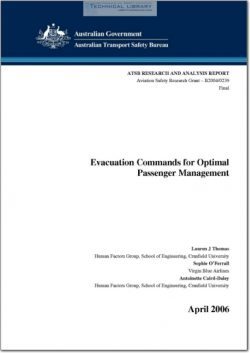ATSB-B2004-0239

- Version
- 139 Downloads
- 3.19 MB File Size
- 1 File Count
- August 9, 2016 Create Date
- August 9, 2016 Last Updated
Evacuation Commands for Optimal Passenger Management

This report describes a two-phase research program undertaken by Cranfield University in collaboration
with Virgin Blue Airlines. Phase I involved a best practice forum, initiated via the Asia Pacific Cabin
Safety Working Group of the Australian Society of Air Safety Investigators, to investigate current practice
in managing passengers in emergency situations. The forum was followed up with a questionnaire survey
of, and discussions with, various operators. The results showed that operators used a variety of commands
to manage passengers in emergency situations, and that while some operators provided stringent
procedures, others accepted that cabin crew may need to adapt commands and procedures to deal with the
situation at hand.
The results from Phase I were used to design an experiment conducted as Phase II of the research. This
second study was conducted at Cranfield University in the UK; it involved 159 members of the public
taking part in a series of experimental evacuation trials. Participants first completed a questionnaire
detailing the commands that they thought would be effective in managing passengers in emergency
situations. The results provided an insight into passenger expectations of commands and emergency
instructions.
The same participants then took part in a session of four evacuation trials using the Boeing 737 simulator
and Large Cabin Evacuation Simulator, both located at Cranfield University in the UK. In the Boeing 737
simulator, the independent variables were an active or a passive safety briefing, and the level of situation
specific instruction provided by the cabin crew. In the Large Cabin Evacuation Simulator, the independent
variables were the visibility of the cabin crew and the use of dual-lane commands. Analysis was
undertaken of time-coded evacuation footage and post-evacuation questionnaires. The results showed that
an active safety briefing had significant advantages over a passive safety briefing, and that the visibility of
the cabin crew influenced passenger perceptions of evacuation effectiveness. Implications for operators are
discussed.
| File | Action |
|---|---|
| ATSB-B2004-0239 Evacuation Commands for Optimal Passenger Management.pdf | Download |
